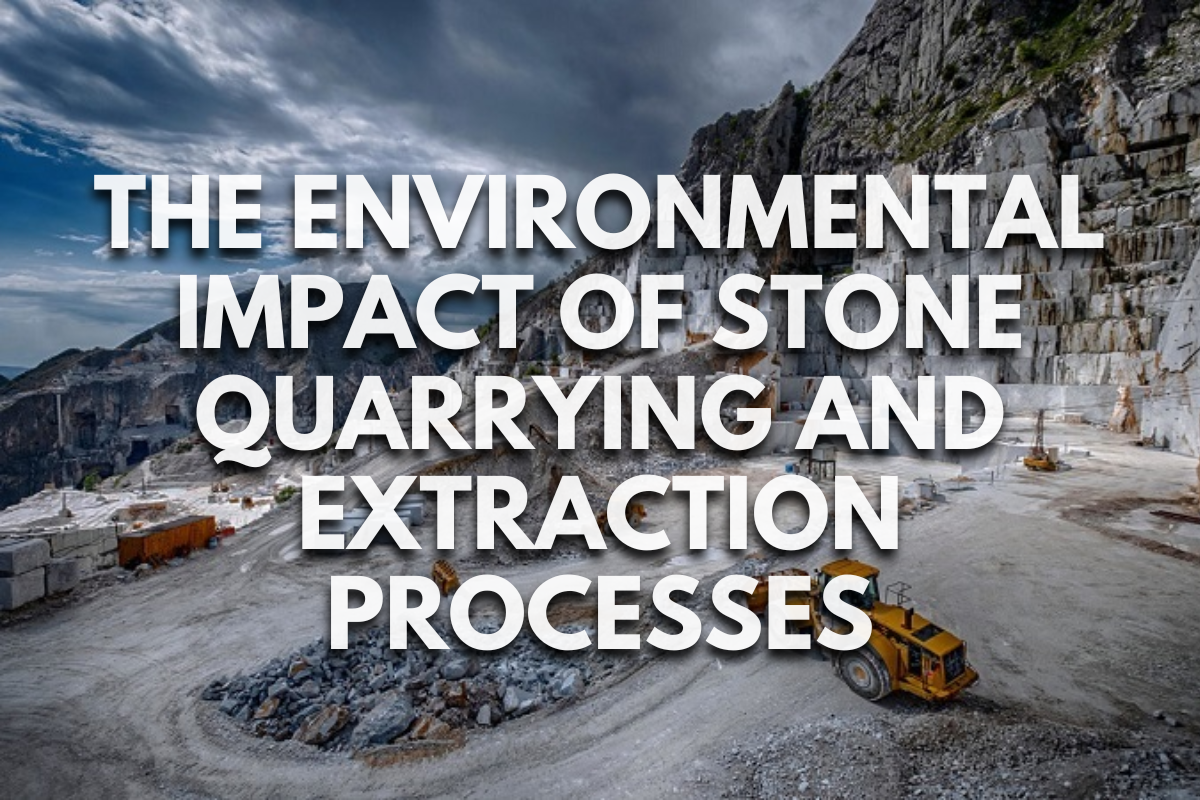
Stone quarrying and extraction processes pose a significant environmental problem.
Have you considered the detrimental effects on ecosystems, air quality, and water resources?
Discover sustainable practices and regulatory measures in our comprehensive article to mitigate the environmental impact.
Understanding Stone Quarrying and Extraction
Stone quarrying involves the extraction of natural stones from the earth’s crust for various purposes, including construction, decoration, and manufacturing. The process typically begins with locating suitable stone deposits through geological surveys.
Once identified, the quarrying process commences with heavy machinery to remove large blocks of stone from the ground.
Extraction methods vary depending on the type of stone and the site’s geological characteristics. Common techniques include drilling, blasting, and cutting. Explosives are often used to break apart rock formations and facilitate extraction.
After extraction, the stones undergo further processing, such as cutting, shaping, and polishing, to meet specific requirements for construction or other applications. This processing may occur on-site at the quarry or off-site facilities.
Stone quarrying and extraction can have significant environmental impacts, including habitat destruction, soil erosion, air and water pollution, and landscape alteration. Understanding these processes is essential for implementing effective environmental management strategies and promoting sustainable practices in the stone industry.
Environmental Impact on Land
- Habitat destruction and fragmentation due to physical alteration of the landscape
- Displacement of wildlife and disruption of ecological processes
- Soil erosion and degradation from the removal of vegetation and topsoil
- Loss of soil fertility and decreased soil quality
- Increased risk of sedimentation in nearby water bodies
- Adverse effects on aquatic ecosystems and water quality
- Long-term environmental challenges in abandoned quarries, including invasive species proliferation and contamination risks
- Mitigation measures and restoration efforts are necessary to promote sustainable land use practices and minimise ecological damage.
Environmental Impact on Air Quality
- Release of particulate matter (PM) during drilling, blasting, and crushing activities
- PM pollution can lead to respiratory problems and other health issues
- Emission of nitrogen oxides (NOx), sulfur dioxide (SO2), and volatile organic compounds (VOCs)
- These pollutants contribute to smog and ground-level ozone formation
- Diesel-powered machinery emits nitrogen dioxide (NO2) and particulate matter
- Measures like dust suppression techniques and machinery optimisation can mitigate air quality degradation
- Implementing air quality monitoring programs is essential for assessing and addressing the impact on nearby communities.
Environmental Impact on Water Resources
- Alteration of hydrological patterns due to removal of vegetation and topsoil
- Increased erosion, sedimentation, and flooding in nearby water bodies
- Contamination of water sources from the discharge of pollutants like sediment, heavy metals, and chemicals
- Leaching of pollutants into groundwater, compromising water quality
- Risks to human health and aquatic ecosystems
- Lowering of water tables impacting water availability for communities, agriculture, and wildlife
- Mitigation measures include erosion and sediment control, proper wastewater management, and groundwater quality monitoring
Effects on Wildlife and Ecosystems
- Habitat destruction and fragmentation due to physical alteration of the landscape during quarrying activities
- Displacement of wildlife species from their natural habitats, leading to population declines and loss of biodiversity
- Disruption of ecological processes and food chains, affecting the balance of ecosystems
- Increased risk of invasive species colonisation in disturbed areas, further threatening native flora and fauna
- Loss of nesting sites, shelter, and food sources for various wildlife species
- Negative impacts on endangered and sensitive species that rely on intact habitats for survival
- Alteration of natural watercourses and wetland habitats, affecting aquatic ecosystems and associated wildlife
- Implementation of habitat restoration and conservation measures to mitigate the effects on wildlife and ecosystems, including reforestation, habitat enhancement, and protected area designation
Energy Consumption and Carbon Footprint
- Stone quarrying and extraction processes require significant energy inputs, contributing to their carbon footprint. The extraction of natural stones involves using heavy machinery, such as excavators, loaders, and haul trucks, which consume large amounts of fossil fuels.
- Energy-intensive processes like drilling, blasting, and crushing contribute to energy consumption and greenhouse gas emissions.
- Transportation of extracted stone materials to processing facilities and end-users, typically using diesel-powered trucks or other vehicles, also adds to the carbon footprint.
- Moreover, the processing of stone materials, including cutting, shaping, and polishing, requires energy from electricity or other sources, further contributing to carbon emissions.
- Reducing energy consumption and carbon footprint in the stone quarrying industry is crucial for mitigating climate change impacts. Implementing energy-efficient technologies, optimising transportation logistics, and utilising renewable energy sources can help minimise the environmental impact of stone extraction processes while promoting sustainability in the industry.
Climate Change Implications
- Increased greenhouse gas emissions from energy-intensive quarrying processes: Contribute to global warming and climate change.
- Deforestation and habitat destruction associated with stone quarrying: Reduce carbon sequestration capacity, exacerbating climate change effects.
- Alteration of landscapes and hydrological patterns: Disrupt local ecosystems, increasing climate-related risks such as flooding and erosion.
- Transportation of stone materials: Emits additional greenhouse gases, further contributing to climate change.
- Stone quarrying’s climate change implications: Emphasize the urgency of adopting sustainable practices to minimise environmental impact and mitigate climate-related risks.
Mitigation Measures and Best Practices
Implementing effective mitigation measures and adopting best practices are essential for minimising the environmental impact of stone quarrying and extraction processes. Some key strategies include:
- Environmental Impact Assessments (EIAs): Conduct thorough EIAs before initiating quarrying operations to identify potential environmental risks and develop mitigation plans.
- Sustainable Quarrying Practices: Promote sustainable quarrying techniques, such as selective extraction methods and quarried areas’ reclamation, to minimise habitat destruction and landscape alteration.
- Dust Suppression Techniques: Employ dust suppression measures, such as water spraying and covering conveyor belts, to reduce airborne dust emissions and protect air quality in surrounding areas.
- Water Management: Implement proper wastewater management systems to prevent contamination of water sources and minimise the impact on aquatic ecosystems.
- Energy Efficiency: Invest in energy-efficient machinery and equipment to reduce energy consumption and greenhouse gas emissions associated with quarrying activities.
- Community Engagement: Engage with local communities and stakeholders to address concerns, promote transparency, and ensure quarrying operations benefit the community while minimising negative impacts.
- Regulatory Compliance: Adhere to relevant environmental regulations and standards to ensure compliance and accountability in quarrying operations.
Stakeholder Engagement and Community Involvement
Effective stakeholder engagement and community involvement are crucial to mitigating the environmental impact of stone quarrying and extraction processes. Engaging with stakeholders, including local communities, government agencies, environmental organisations, and industry representatives, fosters transparency, collaboration, and shared decision-making.
Community involvement initiatives such as public consultations, information sessions, and participatory decision-making processes enable residents to voice their concerns, provide feedback, and contribute to environmental management strategies.
Regulatory Framework
A robust regulatory framework is essential for managing the environmental impact of stone quarrying and extraction processes. Local, regional, and national government agencies enact regulations and guidelines to ensure compliance with environmental standards and protect natural resources.
These regulations typically cover various aspects of quarrying operations, including land use, air and water quality, wildlife conservation, and rehabilitation of quarried areas.
Environmental Impact Assessments (EIAs) are often required before commencing quarrying activities to assess potential environmental risks and propose mitigation measures.
Permitting processes ensure quarry operators adhere to environmental regulations and obtain necessary approvals before initiating operations.
Regular monitoring and enforcement of regulatory compliance are crucial for minimising environmental harm and holding quarry operators accountable for their actions. Authorities may impose fines, penalties, or even suspension of operations for non-compliance with environmental regulations.
Conclusion: Call to Action
While stone quarrying has undeniable environmental consequences, proactive measures such as stakeholder engagement, regulatory enforcement, and sustainable practices offer pathways to mitigate its impact.
Let’s advocate for stringent regulations and responsible quarry management to safeguard our ecosystems for future generations.
More To Explore

How to Tell If Stone Is Porous or Not
When selecting stone for your home or project, knowing whether it’s porous can make a huge difference. Porosity affects how your stone absorbs water, stains,

Split Face Stone: What It Is and When to Use It
Looking for a unique, durable material to elevate your next project? Split face stone might be the perfect choice. Known for its textured finish and


